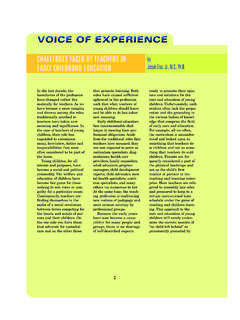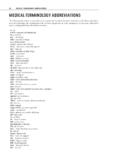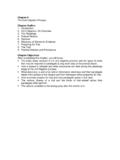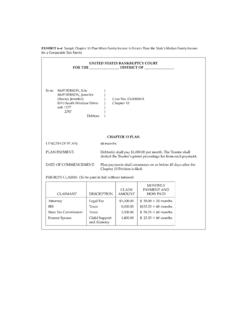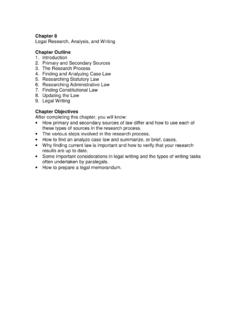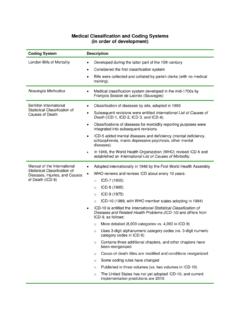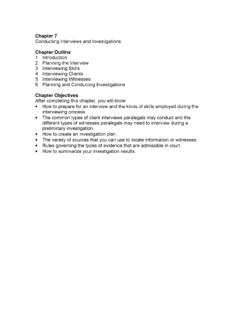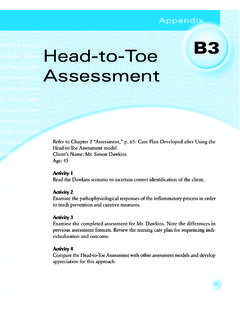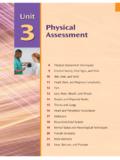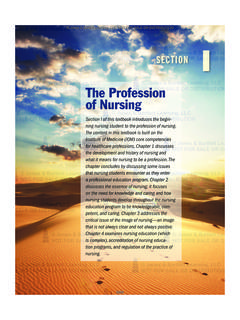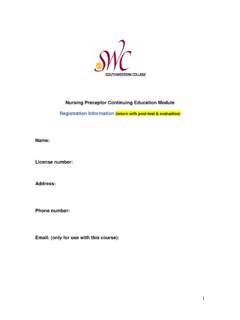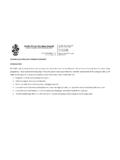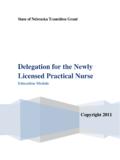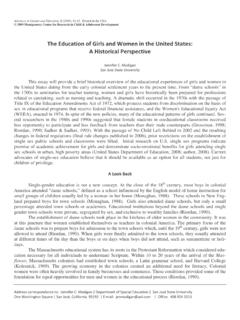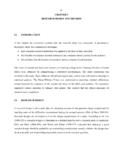Transcription of Research and Evidence-Based Practice
1 CHAPTER 3. Research and Evidence-Based Practice . By changing nothing, we hang on to what we understand, even if it is the bars of our own jail. John LeCarre Competencies 1 Explain the basis for Research and knowledge development in nursing . 2 Describe the steps in the Research process. 3 Explain the responsibilities of the researcher in guarding the rights of Research par- ticipants and others who assist in the Research study. 4 Identify the various applications of nursing Research in nursing Practice . 5 Describe how Evidence-Based Practice is used to guide clinical decision making. 6 Discuss the trends occurring in health care that will influence the priorities for nursing Research .
2 48 Unit I nursing 's Perspective: past , present , and future KEY TERMS code of ethics, technical expertise, professional stan- dards, altruistic service, and public trust. The main abstract characteristics of a profession are established, special- concepts ized training in a body of abstract knowledge and a col- conceptual framework lectivity of service orientation. conceptualization The science of nursing knowledge is established construct by the same systematic, investigative process used by dependent variable all science- based disciplines, the Research process. Evidence-Based Practice Research is a systematic method of exploring, describ- full disclosure ing, explaining, relating, or establishing the existence hypothesis of a phenomenon, the factors that cause changes in the independent variable phenomenon, and how the phenomenon influences informed consent other phenomena.
3 nursing Practice activities are sub- nursing Research stantiated as predicting valid and reliable outcomes for primary source clients (the individual, family, group, or community). qualitative analysis only after a body of knowledge has been established qualitative Research and confirmed by numerous Research efforts. quantitative Research recontextualizing Historical Development Research Research design nursing Research is aligned with the founder of modern secondary source nursing , Florence Nightingale. Nightingale believed theory that through observation, nurses could best determine value care for patients. This early emphasis on systematic variable observation, as opposed to a trial-and-error approach in providing patient care, planted the seeds for the evolu- tion of nursing science a unique body of nursing knowledge (Brockopp & Hastings-Tolsma, 2003, p.)
4 5). This chapter explores the scientific foundation on The groundwork established by Nightingale for using which the knowledge base of the profession has been Research to direct client care was not sustained by sub- and is being built. nursing Research is a scientific sequent nursing leaders because of two forces that had a process that validates and refines existing knowledge direct impact on nursing 's future . First, societal norms and generates new knowledge that directly and indirectly basically excluded women from becoming scientists;. influences nursing Practice (Burns & Grove, 2001, therefore, initiating or participating in scientific discov- p. 4).
5 Evidence-Based Practice is using the best evi- ery ( Research ) was not an option for women. The second dence available to guide clinical decision making. The force dealt with the training as opposed to the educa- identification of the knowledge base for nursing Practice tion of nurses. contributes to achieving client outcomes and making In 1923 Teacher's College at Columbus University nursing Practice credible. The emphasis on quality care offered the first educational doctoral program for nurses. based on evidence and Research is an increasing focus in The first master's of nursing degree was offered at Yale all areas of health care. The challenge to nurses is to University in 1929.
6 The placement of nursing education determine the interrelatedness of nursing Research to in the university setting is credited to three key studies Evidence-Based Practice : Does a solid Research base that addressed educational reform in nursing : the Nutting exist that will provide evidence of the nursing actions report, 1912; the Goldmark report, 1923; and the that are effective in promoting positive patient outcomes? Burgess report, 1926. In 1932 the Association of Collegiate Schools of nursing (ACSN) was organized to Research : Substantiating promote the conduct of Research to improve education and Practice . The ACSN established the first Research the Science of nursing journal in nursing , nursing Research , in 1952.
7 nursing is a profession characterized by educational Research activities during the 1940s and early standards, autonomy, socialization, an established 1950s focused on the organization and delivery of nurs- knowledge base, licensure, formal entry examinations, ing services: staffing patterns; nursing personnel and Chapter 3 Research and Evidence-Based Practice 49. patient satisfaction; and patient classification systems. The movement of the 1980s and 1990s focused on Care delivery systems such as comprehensive care, home clinical nursing Research as many nurses obtained care, and progressive care were evaluated. Results of master's and doctoral degrees, and postdoctoral edu- these evaluations laid the foundation for the develop- cation was encouraged for nurse researchers.
8 The ment of self-study manuals that were the precursors of number of nursing Research journals increased during today's quality assurance manuals. the 1970s and 1980s to include journals such as The American Nurses Association (ANA) con- Research in nursing and Health, Advances in nursing tributed to the advancement of nursing Research . In 1950 Science, Applied nursing Research , and nursing the ANA sponsored a 5-year study on nursing functions Science Quarterly. and activities; the findings were reported in a document Federal involvement in nursing Research dates back entitled Twenty Thousand Nurses Tell Their Story. This to 1946 with the establishment of the Division of study benchmarked the development of ANA statements nursing within the Office of the Surgeon General.
9 In on functions, standards, and qualifications for profes- 1955, the first extramural nursing Research program was sional nurses in 1959. Concurrently clinical Research established in the Research Grants and Fellowship began expanding as nursing specialty groups developed Branch of the Division of nursing Resources, and the standards of care. National Institutes of Health (NIH) established the nursing Research in the late 1950s and early 1960s nursing Research Section within the Division of focused on the effective educational preparation of pro- Research Grants to conduct scientific review in the field fessional nurses. One outcome was the development of a of nursing .
10 The impetus for establishing the National 2-year associate degree nursing program in the junior Institute of nursing Research (NINR) came from the college setting by Montag. During this era several orga- findings of two federal studies: nizations were established that furthered nursing 1. The 1983 report by the Institute of Medicine recom- Research by either promoting, expanding, or disseminat- mending that nursing Research be included in the ing study findings: the Institute for Research and Service mainstream of biomedical and behavioral science in nursing Education at Teacher's College, 1952; the 2. The 1984 NIH Task Force study found that nursing American Nurse's Foundation, 1955; ANA Committee Research activities to be relevant to the NIH mission on Research and Studies, 1956; Department of nursing Research , Walter Reed Army Hospital, 1957; Southern In 1986 these findings led to legislative action that estab- Regional Educational Board (SREB), 1957; Western lished the National Center for nursing Research (NCNR).
